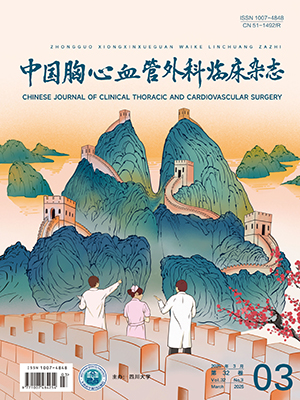| 1. |
曾理平, 王志田, 何哲浩, 等. 达芬奇机器人与胸腔镜下纵隔肿瘤切除术的回顾性队列研究. 中国胸心血管外科临床杂志, 2020, 27(3): 279-283.
|
| 2. |
周振宇, 谭锋维, 滕啸, 等. 2022纵隔及胸壁肿瘤围手术期及全程化综合诊治中国专家共识. 中国胸心血管外科临床杂志, 2023, 30(3): 325-332.
|
| 3. |
查健. 胸腔镜及传统开胸手术治疗纵隔肿瘤效果对比. 医学食疗与健康, 2022, 20(1): 90-93.
|
| 4. |
Sato T, Kazama T, Fukuzawa T, et al. Mediastinal tumor resection via open or video-assisted surgery in 31 pediatric cases: Experiences at a single institution. J Pediatr Surg, 2016, 51(4): 530-533.
|
| 5. |
Landreneau RJ, Dowling RD, Castillo WM, et al. Thoracoscopic resection of an anterior mediastinal tumor. Ann Thorac Surg, 1992, 54(1): 142-144.
|
| 6. |
Friedant AJ, Handorf EA, Su S, et al. Minimally invasive versus open thymectomy for thymic malignancies: Systematic review and meta-analysis. J Thorac Oncol, 2016, 11(1): 30-38.
|
| 7. |
李卿. 单孔与三孔胸腔镜手术治疗纵隔肿瘤患者的效果比较. 中国民康医学, 2022, 34(21): 148-150, 165.
|
| 8. |
Yoshino I, Hashizume M, Shimada M, et al. Thoracoscopic thymomectomy with the da Vinci computer-enhanced surgical system. J Thorac Cardiovasc Surg, 2001, 122(4): 783-785.
|
| 9. |
袁张强, 路志凯. CT扫描诊断胸部肿瘤的临床价值分析. 影像研究与医学应用, 2021, 5(19): 124-125.
|
| 10. |
韩英杰, 张卫锋, 任占良, 等. 单孔电视胸腔镜手术治疗后纵隔神经鞘瘤. 中国现代手术学杂志, 2020, 24(3): 183-187.
|
| 11. |
王涛, 王森, 陈立材. 胸腔镜手术与开胸术对纵隔肿瘤的疗效比较. 中华心脏与心律电子杂志, 2019, 7(4): 204-207.
|
| 12. |
Wu CF, Gonzalez-Rivas D, Wen CT, et al. Single-port video-assisted thoracoscopic mediastinal tumour resection. Interact Cardiovasc Thorac Surg, 2015, 21(5): 644-649.
|
| 13. |
Shen C, Li J, Li J, et al. Robot-assisted thoracic surgery versus video-assisted thoracic surgery for treatment of patients with thymoma: A systematic review and meta-analysis. Thorac Cancer, 2022, 13(2): 151-161.
|
| 14. |
汪明敏. 达芬奇机器人纵隔肿瘤切除术的学习曲线. 大连医科大学, 2016.
|
| 15. |
张乔冶. 达芬奇手术机器人系统及其应用. 医疗装备, 2016, 29(9): 197-198.
|
| 16. |
杜志江. 达芬奇手术机器人系统技术分析. 机器人技术与应用, 2011, 7(4): 14-16.
|
| 17. |
Nakamura H, Taniguchi Y. Robot-assisted thoracoscopic surgery: Current status and prospects. Gen Thorac Cardiovasc Surg, 2013, 61(3): 127-132.
|
| 18. |
Li Q, Sihoe A, Wang H, et al. Short-term outcomes of single- versus multi-port video-assisted thoracic surgery in mediastinal diseases. Eur J Cardiothorac Surg, 2018, 53(1): 216-220.
|
| 19. |
Shibasaki S, Suda K, Nakauchi M, et al. Non-robotic minimally invasive gastrectomy as an independent risk factor for postoperative intra-abdominal infectious complications: A single-center, retrospective and propensity score-matched analysis. World J Gastroenterol, 2020, 26(11): 1172-1184.
|
| 20. |
Jessica DB, Dominic M, Geeta A. Systemic response to surgery. Surgery (Oxford), 2023, 41(2): 117-121.
|
| 21. |
Zheng J, Wang Y, Zhang J, et al. 5G ultra-remote robot-assisted laparoscopic surgery in China. Surg Endosc, 2020, 34(11): 5172-5180.
|




